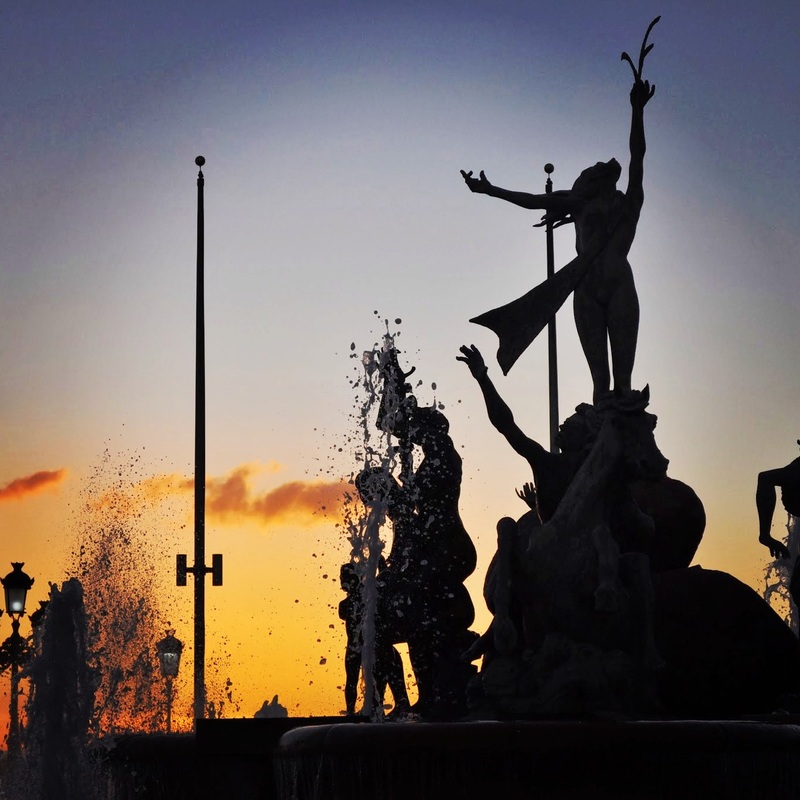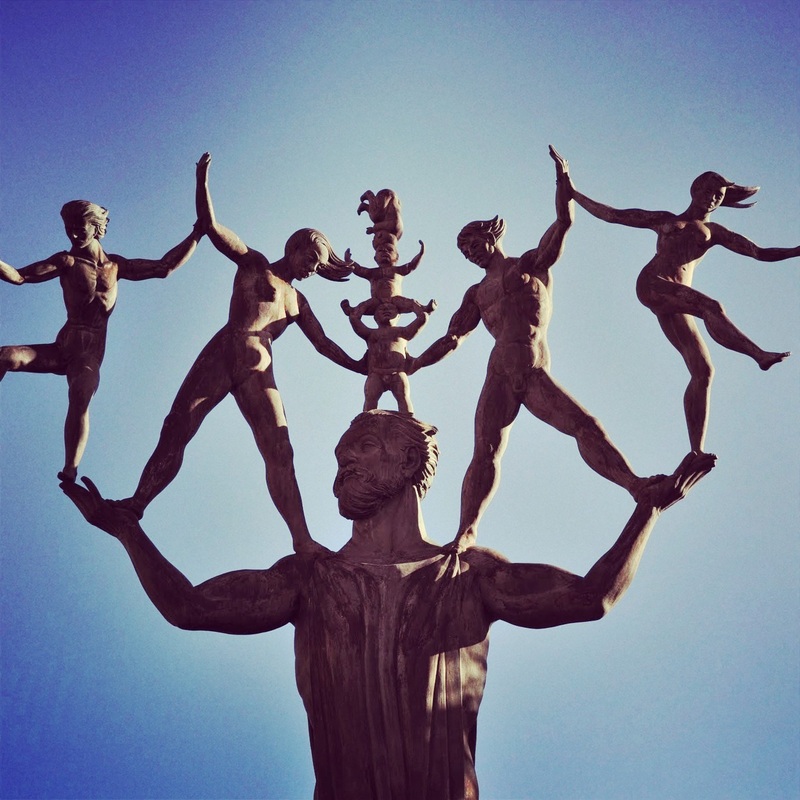|
Our travels introduced us to many beautiful landscapes, intriguing cultures, questionable food and, well, really odd clothing. Here are the top five bizarre wearables we observed: Iceland's climate is harsh - cold, windy and wet - so one must protect the entire face from freezing, including the beard and mustache. The beardcap does just that. Made from soft lambswood, it is a modern day "lambshed-hood" which was traditionally worn by Icelandic farmers walking long distances to their field sheds. Vík Prjónsdóttir produces these quirky caps which come in two styles - the Farmer and the Gentleman. Read more about our adventures in Iceland here. On the small island of Taquile, in Lake Titicaca, Peru, the men wear belts made from their wives' hair. A young woman will use her shiny long hair to make a marriage belt which is a gift for her future husband. The bride mixes her hair with alpaca hair and the result is a black and white striped belt that her husband will wear every day for the rest of his life. The belt is sturdy and worn like a girdle so it supports his lower back. They say it helps the kidneys and prostate so in essence the bride is making a belt to protect the health of her future husband. Read more about Taquile, Peru here. A common sight in China is a toddler missing a critical component of his wardrobe. They call these toilet training pants or split pants, and they feature a big opening in the crotch area (no diaper). The parent/grandparent will regularly fold the kid in half, bum towards the ground, and urge the baby to take care of business. You see it happening everywhere - on the sidewalk, in the park, over a garbage can at the train station, etc. We took extra care to avoid all puddles after seeing this! To read more about China, check out my China blog posts here. The people pictured below are not Mexican luchadores or Marvel's latest superheroes. They are Chinese beachgoers wearing a form of extreme sun protection called the facekini. While the Icelandic beardcaps provide protection from the cold, the facekini provides protection from UV rays and jellyfish. In Asia, most people consider tanned skin to be less attractive than pale skin because a tan implies peasantry while pale skin implies you lead a pampered life. We often saw Asian tourists and locals cover up their skin and wear wide brim hats on sunny days. Drugstores advertised skin bleachers as opposed to self-tanners popular here in the US. Well, the facekini takes sun protection to a new level and has grown in popularity among the Chinese, particularly those from Quingdao. While I'm typically happy with sun-tan lotion, I could have used a facekini while snorkeling among Thailand's stinging sea bees! Females of all ages in China were sporting headbands with animal ears. Typically they were cat ears but we saw lots of variations - bunnies, bears, mice, and my favorite... giraffes.
0 Comments
People often ask me and Chris about our favorite clothes from our 8 month trip around the world. Since we were each living out of a 55L backpack, we did our best to make sure every piece was multi-purpose, easy to wash and durable; traits that are hard to balance with style. Here are our top 10 most useful clothing items from our trip around the world: 1. Merrell Dash Glove Women's ShoesThese were my only sneakers for the entire trip and they were comfortable, light, flexible and easy to pack. After 8 months of hiking, walking, and running around the world, these Merrell shoes are still in great shape! Chris originally packed a pair of Saucony running shoes but they quickly developed holes in the mesh so he parted ways with them and purchased a pair of sturdy men's hiking Merrells, which still look brand new today. (As a side note, the Merrells were the only size 13 shoes he could find in all of Hong Kong, so it worked out well). 2. Mango Embroidered White TankI picked up this tank at Mango in Barcelona and wore it all the time. I loved it because it was loose fitting (thus it didn't get sweaty when I got sweaty), the white color kept me cool, it was easy to layer, easy to wash, dried quickly, and it didn't really wrinkle. I wore it everywhere, as evidenced by the pictures below. 3. Puma Anorak Sport Lifestyle JacketI purchased this Puma jacket in Boston years ago. It was perfect for my trip around the world because:
I couldn't find the jacket online so I think Puma discontinued this product. Please comment if you find something similar! 4. Urban Outfitters ScarfA scarf is a travel must. I used this Urban Outfitters scarf every day. I washed it regularly, dried it overnight and it never wore out. Not one hole! The pattern hid wrinkles and the color matched with most things. Originally, I had brought another colorful eternity scarf on the trip but eventually sent it home. While I love the way eternity scarves look, I don't recommend them if you have limited packing space. Why? Eternity scarves are less multi-purpose than a traditional scarf which can be used a shawl, "hood", sarong and even a substitute for a towel on the beach! 5. Elastic Tube Maxi Skirt/DressI picked up this skirt/dress for $5 at an outdoor market in Cambodia and used it all the time. Since women are not allowed to expose their legs in the temples, the long skirt was perfect because it covered my legs, kept me cool-ish and when I left the temples I could turn it into a short skirt by tying it around my waist. I also used this as a beach cover-up/sarong as well as a beach "towel". At night, the long skirt even kept the mosquitos off my legs. No need to buy one of these before your trip - they are usually on sale at most outdoor markets in warm destinations. 6. Aqua Print Dress/TunicI picked up this dress in a German department store called Karstadt. It was the middle of a very hot summer and I needed a lightweight sundress to stay cool and somewhat stylish. This dress was perfect. I was so tired of wearing black and white so the colorful tribal print was a nice change of pace. The best part about this dress was that it was a loose-fitting polyester dress. This meant that it was incredibly lightweight, NEVER wrinkled, and dried quickly. It kept me cool on sweltering days and on chilly days, I'd throw on a pair of leggings, scarf and my bomber jacket for warmth. You can find Aqua dresses at Bloomingdales in the US. Chris found the following items especially useful: 7. eBags Packing CubesThese packing cubes were key. We each had 4 slim cubes in our backpacks and it made finding things so easy. We'd usually put warmer weather clothes in separate bags from cooler weather clothes so we'd only have to unpack a couple cubes at each destination. 8. ExOfficio Boxer BriefsTwo of these ExOfficio boxer briefs lasted Chris 8 months! They usually dry in just an hour or two. Every night he'd wash one pair for following day. 9. REI Convertible PantsI'm not the biggest fan of convertible pants (especially on women), but Chris loved his REI Sahara convertible pants. They immediately won him over because they come in the hard-to-find 36" inseam. Chris found them incredibly convenient for temperature change or when he had to cover up his legs to go into a religious site. He also loved the cargo pockets and the super lightweight material dried in a jiffy (unlike the pair of Dockers he brought). One day he left them out to dry on our balcony in Berlin and the shorts blew away, never to be seen again. Luckily we were heading back to the States for a few days shortly thereafter so he was only deprived of his pants for one week. 10. Gap Cotton Button Down Plaid ShirtChris purchased this shirt a few years ago and it was a staple in his weekend wardrobe prior to the trip. So he brought it along and wore it frequently, in both hot and cold weather. The shirt has snaps instead of buttons which makes it easy to take on and off and the loose fitting cotton material kept him cool in the sun. Other benefits were that it rarely wrinkled and dried quickly.
On this Valentine's Day, I thought it would be fun to highlight a romantic destination that is a little unexpected. When people think of romantic cities, Paris or Venice might immediately come to mind, and for good reason! Lima, on the other hand, is not a city that most people around the world associated with love, passion and sweethearts. But the Peruvians are quite romantic and dedicated an entire park to love - complete with poetry, art and dramatic views. The Love Park, or Parque del Amor, is located in the Miraflores area of Lima. It is situated along the malecon which lies atop massive cliffs that cascade into a wide beach along the Pacific. The view can be breathtaking on a clear day, and especially romantic at sunset. Legend has it that the origins of Parque del Amor lie with the Peruvian poet Antonio Cilloniz's lament "In the cities, they do not build monuments to lovers". Cilloniz has a valid point; most cities have monuments to war heroes and battles. This resonated with the town of Miraflores so they built El Parque del Amor in 1993 and opened it on Valentine's Day. The park is dedicated to all lovers and is artfully decorated in colorful mosaics, poems and a massive sculpture by Victor Delfin called El Beso (the kiss) which stands over the words of Anotonio Cilloniz. El Beso features two lovers embracing and is meant to celebrate the lovers who gather to watch the sunset over the Pacific. It's a lovely park and definitely worth a visit if you find yourself in Lima. Happy Valentines Day! I was recently at dinner with friends who had just returned from vacation in Argentina. While enthusiastically discussing some of Argentina's delights - malbec & steak - we eventually arrived on the subject of money. My friends saved a lot of money by brining cash (USD) to Argentina and exchanging their dollars for pesos using an unofficial exchange rate.
US Dollars are currently scarce in Argentina due to the government's tough currency exchange restrictions, intended to help the struggling peso and to discourage citizens from spending their money outside of Argentina. The result? Two exchanges - the official exchange rate from banks and ATMs, and the black market rate also called the "Blue Rate" or "Dollar Blue" which can be obtained from unofficial traders. For example, you might get 7.80 pesos for $1USD using the official rate but you'd get 11.40 pesos for $1USD using the blue rate. As you can see, the savings are significant. Although the blue rate is technically illegal, it's published in Argentina's newspapers, many news outlets report the blue rate when talking about the official rate, and travelers and locals alike regularly take advantage of the discounted rate. Finding Unofficial Traders In order to exchange money using the blue rate, you must find unofficial traders. Your best bet is if you know someone in Argentina who can direct you to a trusted unofficial trader. If that isn't an option, seek out a tour operator online before you arrive or ask your hotel to recommend a "cueva" (it literally means cave, but it's really a functioning exchange business). If that doesn't work, there will be people in the street yelling "Cambio!". While this should be a last resort, you can ask them about their exchange rate and compare it to the published blue rate & official rate. Whether you exchange with unofficial or official traders, there is always a risk you'll get scammed. Make sure you count your money, calculate the exchange and get them to agree on the trade amount BEFORE you hand your cash to the trader. There is also a small chance you might get counterfeit notes, so inspect your bills for signs of forgery. Changing Pesos Back When changing your pesos back to your home currency, you get a better rate on the official market than with the blue rate. However, it's harder to find official traders in Argentina who will take pesos for USD (or EUR/GBPs). You are more likely to be able to trade your pesos once you leave the country. If possible, research beforehand and identify a currency exchange outside of Argentina that trades at the official rate. Arbitrage This dual exchange rate presents an arbitrage opportunity assuming you have left over cash after your trip. For example, say you bring $1,000USD and trade it at the blue rate quoted above for 11,400 pesos. If you were to immediately come home and trade your pesos at the official rate you'd get back $1,460USD, resulting $460USD in profit. Now before you start thinking this is a way to make a lot of easy money, remember that you can't carry around anything over $10,000USD, otherwise you'd have to declare it. And I really wouldn't recommend carrying around a ton of cash anywhere, especially in a foreign country. A Word of Warning Argentina's currency is extremely volatile so keep a close eye on the exchange rate right before you leave and during your trip. This currency has collapsed before and it may happen again. Keeping this in mind, it may be wise to exchange only as much as you'll need on your trip. The last thing you want is to return home with a bunch of pesos only to find out that the currency is worthless. Now that you know how to save money during your next visit to Argentina, how will you spend your extra cash? Planning a trip to Argentina? Check out our recommendations. Those of you who have been following the blog probably noticed pictures of us in t-shirts with TEAM BARBIER written on the back and YOLO in different languages on the front. These shirts were a thoughtful bon voyage gift from my amazing co-workers at Google before we left on our trip. We had a blast taking pics in our Team B shirts around the world. Thank you Team G, from Team B!
In an effort to take advantage of our free time before going back to the daily grind, we booked last minute tickets to San Juan to escape the frigid Boston weather. We enjoyed glorious weather and time with family. PR never looked (and felt) so good.
|
AuthorEva has been traveling for 15+ years, including an 8 month journey around the world. Archives
October 2016
Categories
All
|
|



























 RSS Feed
RSS Feed
